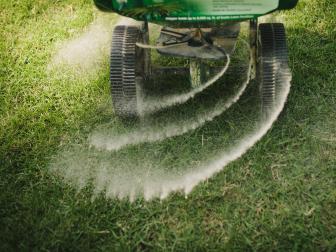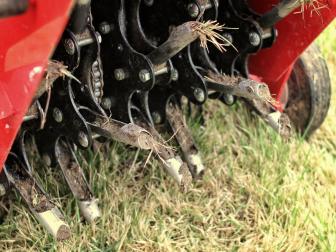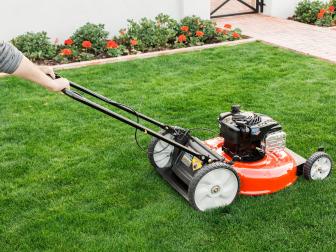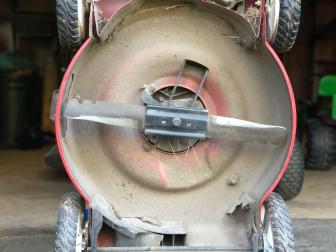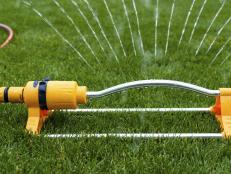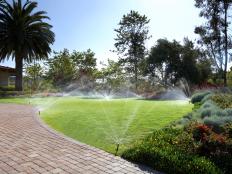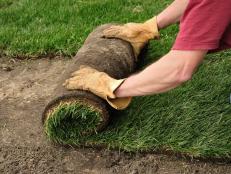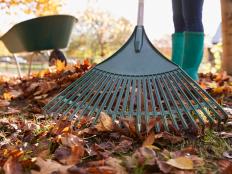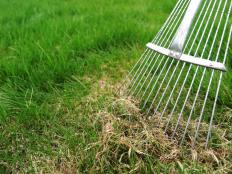How to Water Your Lawn the Right Way
Learn the ins and outs of lawn irrigation, including expert tips on how long to run the sprinkler.
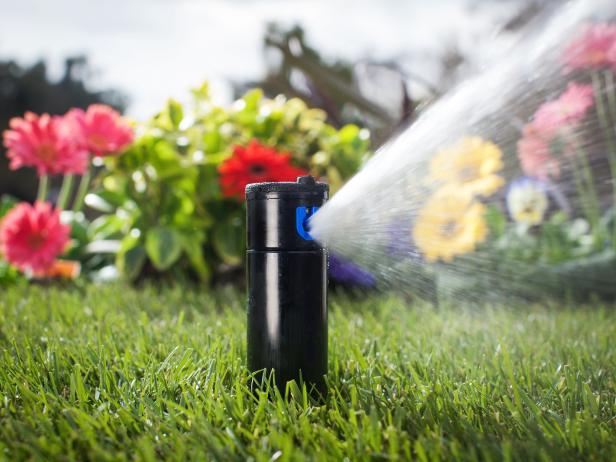
How long to water your lawn depends on, among other factors, sprinkler water pressure. Measure how much water your sprinkler delivers in 15 minutes using a straight-sided can (such as a tuna can) then use that to calculate how long to run your sprinkler to deliver the recommended inch of water per week.

On average, most lawns need about an inch of water per week to stay lush and green. That water can come from rainfall or irrigation. How often your lawn needs a drink depends on a host of factors, including things like soil type, sunlight and regional climate.
In many municipalities, water restrictions are the norm and lawn watering is high on the list of wasteful water activities. Fine-tune your lawn watering skills with these irrigation tips and answers to popular questions about how to water lawns the right way.
How Long Should I Water the Lawn?
Unlike with cooking time in a recipe, there's no optimal time to recommend for how long to run the sprinkler. Factors such as sprinkler water pressure affect the length of time you should keep the sprinkler running to deliver the recommended amount of water to your lawn.
Clint Waltz, a turfgrass extension specialist with the University of Georgia, says watering to a depth of one inch per week is the rule of thumb to follow to encourage the grass roots to grow deep, and to keep a lawn green and growing.
If you want to put your sprinkler on a timer, you can figure out how long to water the lawn pretty easily. Here's how:
- Put out a tuna can, cat food can or any other straight-sided can.
- Run your sprinklers for 15 minutes.
- Measure the depth of water in the can.
- Multiply that measurement by four to figure out much water your sprinkler system can deliver in an hour.
Waltz suggests it's best to water to a depth of 1/2 inch twice per week, but watch for any runoff. Water more frequently and for shorter lengths of time if you see your sprinkler water running down the street and into the storm sewer rather than soaking into your turf.
Does Watering Time Vary by Grass Type?
Not really. The one-inch-per-week rule, delivered over a few irrigation cycles, is good for most all grass types, says Waltz.
When Is the Best Time to Water Your Lawn?
You may have heard the adage: Don't put your grass to bed wet.
It's best to water early in the morning. Watering in the afternoon or evening predisposes the grass to disease. Also, check whether there are restrictions on watering times in your area.
Irrigation timers can help you stick to a schedule that includes watering during low water-use hours, which typically coincide with a predawn irrigation schedule. Watering in the morning also helps to minimize water loss to evaporation.
How Often to Water New Sod?
Newly sodded or seeded lawns need more irrigation than established turf. New sod needs to be watered lightly several times per day (Example: morning, afternoon and late afternoon) for the first 10 to 14 days — enough for the ground beneath the sod to stay wet. Taper off the watering after the first two weeks to encourage grass to sink deep roots.
How Often to Water New Grass Seed?
Twice daily waterings ensure seedling success. A seed starts to germinate once it imbibes water. At that point, the seed must stay wet. Aim to keep that top inch of soil consistently moist, which means three to four light waterings per day. Keep up daily irrigation until you have mowed the grass at least once (twice is even better).
More Lawn Care Advice
13 Tips for Fertilizing Your Lawn
Expert tips on everything from when to fertilize to how to choose the right spreader.
How to Aerate Your Lawn
Give your grass a breath of fresh air with these aerating tips.
Watering Tips
Know Your Soil Type
Learn your yard’s soil type to make the most effective lawn irrigation decisions. For instance, if you see puddling each time you water, your soil likely has high clay content. This type of soil can’t absorb water quickly, but instead requires repeated, shorter watering cycles. On the plus side, clay soil retains water longer than sandy soil, which needs more frequent watering. Take a soil test to learn what kind of soil is hosting your grass and adjust irrigation cycles accordingly. Your local extension service can help with a soil test.
Water Hills and Slopes Differently
When watering slopes or hillsides, tinker with irrigation frequency and timing. You’ll have the best success if you use short watering cycles spaced out over time. If you water a slope first for a brief duration, water another spot in the yard while the slope absorbs the water it received. Cycle back to apply another round of water to the slope. Use this same strategy to water clay soils effectively.
Consider Sun vs. Shade
Grass growing in the shade uses less water than a sun-bathed lawn. In general, you can water shady lawn areas less frequently than sunny ones. The exception, though, is grass growing beneath a tree. In these shady spots, the lawn is competing with tree roots for available moisture. You may need to water these shady lawn areas more frequently than ones that are shaded by a structure. Remember to water deeply to encourage deep grass roots.
Control Water Waste
Note where water delivery is hitting hard surfaces, like walks or driveways, or where puddling is occurring on the lawn. Adjust nozzles and irrigation duration as needed to ensure you're controlling runoff and making the most efficient use of every drop of water.
Set Your Irrigation System Monthly
Reset your irrigation timer monthly. This is one of the most overlooked aspects of a lawn irrigation system. Don’t let your system run on summer settings once your region’s rainy season arrives.
Check the Roots
Every so often, take time to dig into your lawn to see how deeply water is actually penetrating the soil. This is also a good time to take stock of grass roots and soil compaction. If you use a trowel, you can easily inspect soil wetness, water absorption and the existing thatch layer.
Stick a shovel into the soil and lift a section of the turf, and you can get an idea of how deep grass roots are growing. If they’re not reaching beyond 2 to 3 inches, your soil is likely compacted and would benefit from aeration. Healthy grass roots should reach at least 4 inches into the soil.

.-Battle-on-the-Beach-courtesy-of-HGTV.-.jpg.rend.hgtvcom.196.196.suffix/1714761529029.jpeg)




